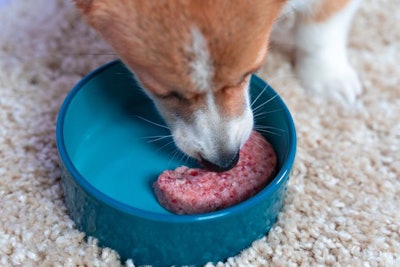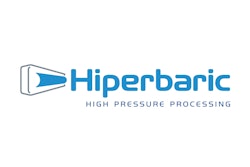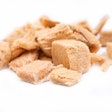
ORIGINALLY PUBLISHED MAY 12, 2022
Raw pet food is growing in popularity, but there are some risks associated with them. High-pressure processing (HPP) could mitigate those risks.
That’s according to Vinicio Serment-Moreno, Ph.D., HPP applications and food processing specialist at Hiperbaric, who spoke at Petfood Forum 2022 in Kansas City, Missouri, USA.
“Raw diets are sought by pet parents because of all the benefits they might have,” including better oral health, increased energy, improved digestion, smaller stools, and more vibrant skin and coat, he said. “Still, there are some risks associated with raw pet food consumption” related to foodborne illness through pathogenic bacteria, viruses and parasites.
These risks can be due to direct transmission of illness from pet to human, improper storage and temperature abuse, and contaminated kitchen utensils or surfaces that come into contact with raw meat.
High-pressure processing is a nonthermal food preservation technology that uses water and high pressure to inactivate foodborne pathogens and spoilage microorganisms, therefore making raw pet food safer for pets and pet parents.
U.S. Food and Drug Administration (FDA) guidance #245 says high-pressure processing should be used to improve food safety and control pathogens.
How does HPP work?
Serment-Moreno, whose company performs HPP on pet food products, explained how the process works.
First, baskets are loaded with packaged raw pet food products, then the baskets enter the high-pressure chamber. The chamber is filled with water and sealed.
High-pressure intensifiers then pump water inside the vessel, which injects up to another 15% water volume to increase the pressure up to 87,000 psi.
Once the maximum pressure level is reached, bacterial inactivation occurs and the pressure is released.
After high-pressure processing is complete, the product can be sold refrigerated or frozen, or further processed into other products.
5 benefits of HPP
Serment-Moreno outlined five main benefits of using HPP for raw pet food products:
- Better food safety because foodborne pathogens are inactivated.
- Companies can develop clean label products without compromising the quality or safety of the food.
- Prevention of recalls related to spoilage or pathogen issues.
- Companies can broaden their distribution area with an extended shelf life.
- More research and development, as companies can explore multiple formulations and packaging options.
HPP stigma based on misinformation
Nicole Lindsley, owner/operator of raw pet food company Steve’s Real Food, who also spoke at Petfood Forum, said her company started using HPP a few years ago, after exploring several options.
“Our hesitation was not based on its effectiveness, but rather more based on the stigma that it had in the raw pet food industry and by a lot of customers that were buying our food,” she said. “We knew it worked to eliminate pathogens, but we didn’t know how it would affect the nutritional bioequivalence.”
Serment-Moreno said research analyzing the health benefits to dogs fed HPP diets found that HPP does not create changes in appearance, color, consistency or smell; HPP raw diets notably increased protein and decreased cholesterol levels in blood; and when compared with a dry extruded diet, there was a higher protein and fat intake with the HPP diet, despite the formulation having less dry matter than the dry food, and the HPP diet notably increased digestibility.
With the enactment of the Food Safety Modernization Act (FSMA), Lindsley said, FDA began enforcing a zero-tolerance rule for bacteria in pet food.
“As you can imagine, this created a lot of chaos in the pet food industry,” she said, because her company and others had to find a five-log reduction kill step.
“We were happy to see that, although there was a negative stigma in the raw pet food industry, it was largely based on misinformation and, through the tests that we’ve been able to do internally and also working with Cold Pressure Council and Hiperbaric, have found out that there’s quite a bit of benefits to using the HPP process – not only in things such as bacteria mitigation, but shelf life extension, and being able to break into new markets,” Lindsley said.
While fresh pet food only accounts for a small sliver of the US$110 billion pet food market, according to Lindsley, “the great thing about that is that pet parents are becoming more and more aware of the importance of nutrition for their pets, and they are wanting to find better options.”














